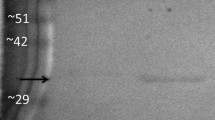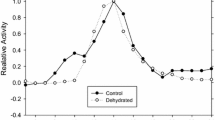Summary
-
1.
Glutamate dehydrogenase (GDH) from the Japanese beetle,Popillia japonica, occurs in tissue specific isozymic forms. Two forms, specific for flight muscle and fat body, were identified and were separable by starch gel electrophoresis and by differential elution from NAD-agarose.
-
2.
The isozymes utilized both NAD(H) and NADP(H) as coenzymes with activity ratios NADH:NADPH of 6:1 for flight muscle and 8:1 for fat body. pH optima for both enzymes were similar.
-
3.
GDH from the two tissues differed kinetically. Affinity for α-ketoglutarate was much higher for the fat body enzyme, S0.5 for the NADH and NADPH linked reactions being 0.81±0.09 and 0.26±0.03 mM for fat body and 2.4±0.03 and 2.3±0.4 mM for flight muscle GDH, respectively.
-
4.
Flight muscle GDH was much more strongly regulated by nucleotides than was the fat body isozyme. The apparent activation constant,K a, for ADP was 2–3 fold lower for the flight muscle enzyme for both forward and reverse reactions and ADP had a greater effect in lowering S0.5 for NH +4 for flight muscle GDH. GTP was a strong inhibitor of flight muscle GDH with apparent inhibitor constants, I50, of 15.5±3.0, 4.0±0.9 and 6.5±0.9 μM for the NADH, NADPH and NAD linked reactions, respectively. Fat body GDH, however, was only weakly affected by GTP with an I50 of 60±6μM for the NAD reaction and I50's of greater than 500 μM for the NADH and NADPH linked reactions.
-
5.
The kinetic properties of the two GDH isozymes suit the probable roles of the enzyme in vivo. Flight muscle GDH has a major role in the oxidation of proline as a fuel for flight. Nucleotide control of GDH would allow enzyme activity to respond to the energy status of the cell and would achieve a rapid activation of GDH at the initiation of flight. Fat body GDH, however, has a major role in the biosynthesis of proline and other amino acids. Enzyme activity is probably regulated by substrate availability, the absence of strong nucleotide regulation allowing enzyme function in high energy, resting states.
Similar content being viewed by others
References
Bond PA, Sang JH (1968) Glutamate dehydrogenase fromDrosophila larvae. J Insect Physiol 14:314–359
Braunstein A (1957) Les voies principales de l'assimilation et dissimilation de l'azote chez les animaux. Adv Enzymol 19:335–389
Bursell E (1975) Glutamate dehydrogenase from the sarcosomes of the tsetse fly and blowfly. Insect Biochem 5:289–297
Bursell E, Slack E (1976) Oxidation of proline by sarcosomes of the tsetse flyGlossina morsitans. Insect Biochem 6:159–167
Frieden C (1965) Glutamate dehydrogenase — Survey of purine nucleotide and other effects on the enzyme from various sources. J Biol Chem 240:2028–2035
Goldin BR, Frieden C (1971) Glutamate dehydrogenases. Curr Top Cell Regul 4:77–117
Hansford RG, Johnson RN (1975) The nature and control of the tricarboxylate cycle in beetle flight muscle. Biochem J 148:389–401
Hemmings BA (1978) Evidence for the degradation of NADP-dependent GDH ofCandida utilis during rapid enzyme inactivation. J Bacteriol 133:867–877
Hemmings BA (1980) Purification and properties of the phosphorylation and dephosphorylation forms of yeast NADdependent GDH. J Biol Chem 255:7925–7932
Job D, Cochet C, Dhein A, Chambaz EM (1978) A rapid method for screening inhibitor effects: Determination of I50 and its standard deviation. Anal Biochem 84:68–77
Male KB, Storey KB (1982) Purification and properties of glutamate dehydrogenase from the cold-hardy gall fly larva,Eurosta solidaginis. Insect Biochem 12:507–514
Mandel LJ, Riddle TG, Storey JM (1980) Role of ATP in respiratory control and active transport in tobacco hornworm midgut. Am J Physiol 238:C10-C14
McGiven JD, Chappell JB (1975) On the metabolic function of glutamate dehydrogenase in rat liver. FEBS Lett 52:1–7
McKenzie EA, Copeland L, Lees EM (1981) Glutamate dehydrogenase activity in developing soybean seed: Kinetic properties of three forms of the enzyme. Arch Biochem Biophys 212:298–305
Sacktor B, Hurlbert EC (1966) Regulation of metabolism in working muscle in vivo. II. Concentrations of adenine nucleotides, arginine phosphate and inorganic phosphate in insect flight muscle. J Biol Chem 241:632–634
Smith EL, Austen BM, Blumenthal KM, Nyc JF (1975) Glutamate dehydrogenases. In: Boyer P (ed) The enzymes, vol 11. Academic Press, New York, pp 293–368
Storey KB, Fields JHA, Hochachka PW (1978) Purification and properties of glutamate dehydrogenase from the mantle muscle of the squidLoligo pealeii. J Exp Zool 205:111–118
Weeda E, Kort AD de, Beenakkers AMTh (1980) Oxidation of proline and pyruvate by flight muscle mitochondria of the Colorado beetle,Leptinotarsa decemlineata Say. Insect Biochem 10:305–311
Author information
Authors and Affiliations
Rights and permissions
About this article
Cite this article
Male, K.B., Storey, K.B. Tissue specific isozymes of glutamate dehydrogenase from the Japanese beetle,Popillia japonica: Catabolic vs anabolic GDH's. J Comp Physiol B 151, 199–205 (1983). https://doi.org/10.1007/BF00689919
Accepted:
Issue Date:
DOI: https://doi.org/10.1007/BF00689919




